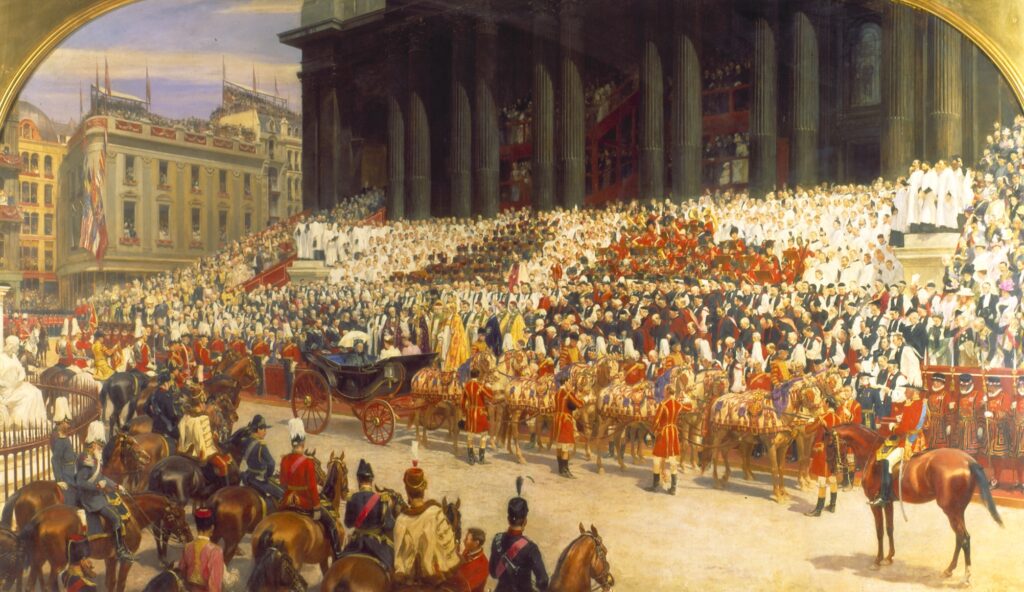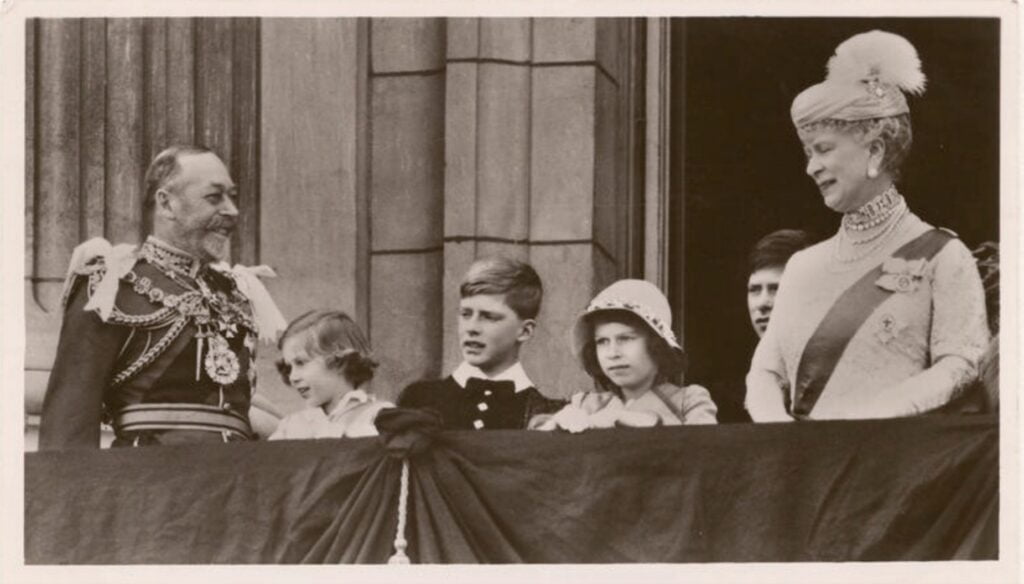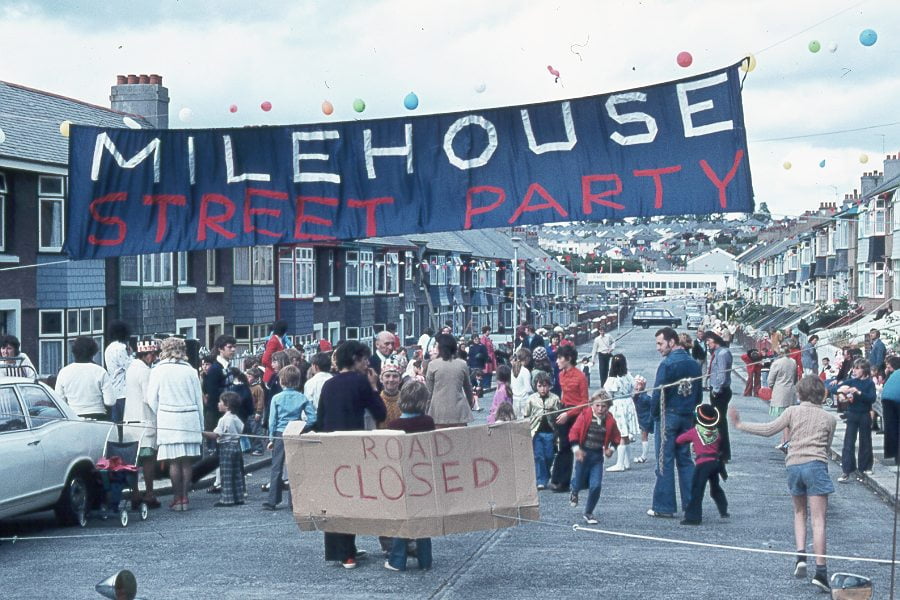Over the last two centuries jubilees have renewed enthusiasm for the monarchy, and sometimes provided distraction during troubled times. They have left a tangible legacy of royal bequests to the public, including bridges, public parks, law courts and hospitals.
Royal Jubilees must embrace dignified and stately ritual as well as offering the British people a chance to celebrate and have fun. They have evolved to comprise a number of elements: a royal service of thanksgiving, chains of beacons and spectacular fireworks, royal parades and processions, flypasts, royal tours and walkabouts, local parties and celebrations in towns and villages all over the country.
Jubilees go hand in hand with the great British tradition of street parties. These evolved from the more rustic celebrations of the 19th century into ‘peace teas’, which were held for children to mark the end of the First World War. Street parties, with their trestle tables, bunting and balloons, have continued to mark our national history: royal jubilees, VE and VJ day, the Coronation. The British love these informal communal affairs, where a democratic spirit prevails and everyone chips in and participates. Eating, drinking and socialising with neighbours is enlivened by traditional games such as sack races or street cricket and live music.
In 1809 celebrations were held for George III’s Golden Jubilee. The War of American Independence and the ongoing Napoleonic wars had taken their toll and the British people were ready for a party. On 25 October 1809 celebrations were held all over the land. The King and his family celebrated in Windsor, but apart from this there was no central organisation of the Jubilee; it sprang out of spontaneous local celebrations, and was a remarkable display of patriotism. In public spaces, towns and villages throughout the land, buildings were illuminated and spectacular firework displays lit up the night sky. People flocked to services of thanksgiving and sat down together to enjoy lavish feasts of ‘Old English Fare’, such as roast oxen and plum pudding.
The King marked the occasion with acts of benevolence: ‘all persons confined for military offences’ were granted an amnesty and released; in Newcastle-upon-Tyne, ten prisoners were released and given half a guinea with which to toast the King’s health.
In 1887 Queen Victoria celebrated her Golden Jubilee. It came at a time when there was significant republican sentiment in Britain – the Queen, lost in deep mourning, had become remote after the death of Prince Albert, and many working class people were struggling with unemployment, food shortages and unusually cold winters. There was much popular opposition to lavish celebrations – in the words of Matty Tate, the ‘Pitman Poet’:
“Why waste we our means Over Kings and Queens Though ever so good they may be? Let the Duke and the Peer With their thousands a year Rejoice if they like, but Oh dear, Oh dear Save the poor from this Jubilee.”
Nevertheless, on 21 June a service of Thanksgiving was held in Westminster Abbey and the blue skies and warm sunshine were hailed as the ‘Queen’s weather’ in the popular press. As well as the usual plethora of fêtes, parties and parades, the Golden Jubilee was marked by a more material, and beneficial, legacy: an abundance of commemorative parks, statues, hospitals, libraries, water fountains.

Ten years later, the Queen celebrated her Diamond Jubilee, the first British monarch to do so. Her Jubilee became a confident celebration of the might and power of the British Empire, and the prime ministers of all the self-governing dominions were invited to London. On 22 June 1897 a spectacular procession of 17 carriages, flanked by a military escort and carrying monarchs, maharajahs and chiefs from all around the world, wended its way along the six-mile processional route from Buckingham Palace to St Paul’s Cathedral, where a service of thanksgiving was to be held. The route, which was bedecked with flags, banners and bunting, crossed London Bridge to take in the poorer boroughs of Southwark and Blackfriars.

The Queen wrote in her journal: “No one ever, I believe, has met with such an ovation as was given to me, passing through those six miles of streets… The crowds were quite indescribable and their enthusiasm truly marvellous and deeply touching.”
The celebrations in 1935 marking the 25th anniversary of George V’s reign, the first time a silver jubilee had been celebrated, were very different. Britain was beset by high unemployment and locked deep in a depression, and the threat of another world war was looming. George V, who had gradually won support from moderate Labour party politicians, had remained popular through the First World War and the economic slump of the 1920s and 1930s – he had, for example, voluntarily offered to reduce the civil list in 1931. In his Jubilee broadcast to the nation he remarked: “In the midst of this day’s rejoicing I grieve to think of the numbers of my people who are still without work. We owe to them, and not least to those who are suffering from any form of disablement, all the sympathy and help that we can give.”
His Jubilee launched with a Thanksgiving service at St Paul’s Cathedral on 6 May, and he was astonished by the enthusiastic reception he received on the streets of London.

On 6 July 1935, he carried out his Silver Jubilee Review of the Royal Air Force at RAF Duxford and RAF Mildenhall, which included 200 aircraft on the ground and a flypast of 350 aircraft. This was the beginning of a new Jubilee tradition, which acknowledged and commemorated the importance of the Royal Air Force.
Over the summer of 1935 George V visited the more deprived areas of London, often with his granddaughters, Elizabeth and Margaret, in tow. He was received with great warmth, and remarked: “I’d no idea they felt like that about me…I am beginning to think they must really like me for myself.”
Once again the Queen’s Silver Jubilee, like her grandfather’s, took place during a time of economic problems and recession. There were some protests from the public, notably the Sex Pistols, whose ‘Stuff the Jubilee’ badges and punk classic ‘God Save the Queen’ expressed some of the feelings of public disquiet.
Although the Jubilee had started with a successful Commonwealth tour in Spring 1977, Jubilee Fever didn’t seem to be sparking back home. However, on 7 June a million people lined the route as the Queen drove by for the official celebration. An astonishing 100,000 street parties sought to recapture the spirit and optimism of the Coronation.


The Queen’s Golden Jubilee in 2002 arrived at a time when the monarchy was struggling: it had been severely shaken by the death of Princess Diana, and there had been some very bad press over royal expenses. In February, just three days before the anniversary of her accession, the Queen’s sister, Princess Margaret died, followed – at Easter – by the Queen Mother. But the Jubilee celebrations were not halted.
This time the Jubilee festivities emphasised accessibility and community, and to reinforce this message the Royal Family stepped down from the balcony and mingled with the crowds on the Mall. The Queen opened up the gardens of Buckingham Palace for a concert, which trumpeted the new era of Cool Britannia, and the building was illuminated with fireworks and lasers.
The Queen toured extensively, both globally and in the United Kingdom. By the end of her Jubilee year she had travelled 40,000 miles and conducted over 50 walkabouts in 70 cities in the UK.
The Diamond Jubilee in 2012 was launched on 3 June with a waterborne flotilla of some 1,000 boats on the River Thames, led by the Queen’s Royal Barge ‘Gloriana’. Thousands of beacons were lit across the Commonwealth on 4 June, and on that day the grounds of Buckingham Palace were opened to 10,000 ticket-holders, who enjoyed a picnic and evening concert. The following day the Queen travelled to the Jubilee service at St Paul’s by car, but made the journey back to Buckingham Palace in an open-topped carriage, to the delight of the general public.
The weekend ended with a balcony appearance by the Queen and senior members of the Royal Family, and a spectacular flypast, which included the last flying Lancaster bomber in Britain. Following the great British tradition, street parties took place across the country, many of them assisted by special lottery loans – the Jubilee Lottery Fund.
Now, ten years later, the Queen celebrates an unprecedented Platinum Jubilee. Once again the nation is preparing for another bonanza of beacons, parades, pageants and parties. It’s time to break out the bunting!


Planning a street party for the Jubilee weekend? We're delighted to be partnering with Party Pieces, which has launched a range of tableware and decorations to commemorate the Queen's 70 years on the throne. The eco-friendly collection, A Great British Party, includes bunting, balloons, cake stands and personalised cake toppers. Shop the range and get planning!
Looks like you haven't made a choice yet.